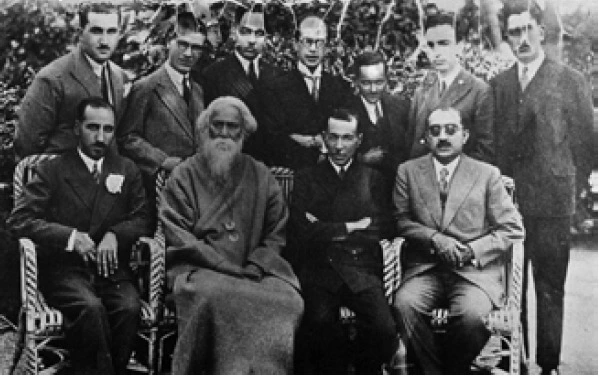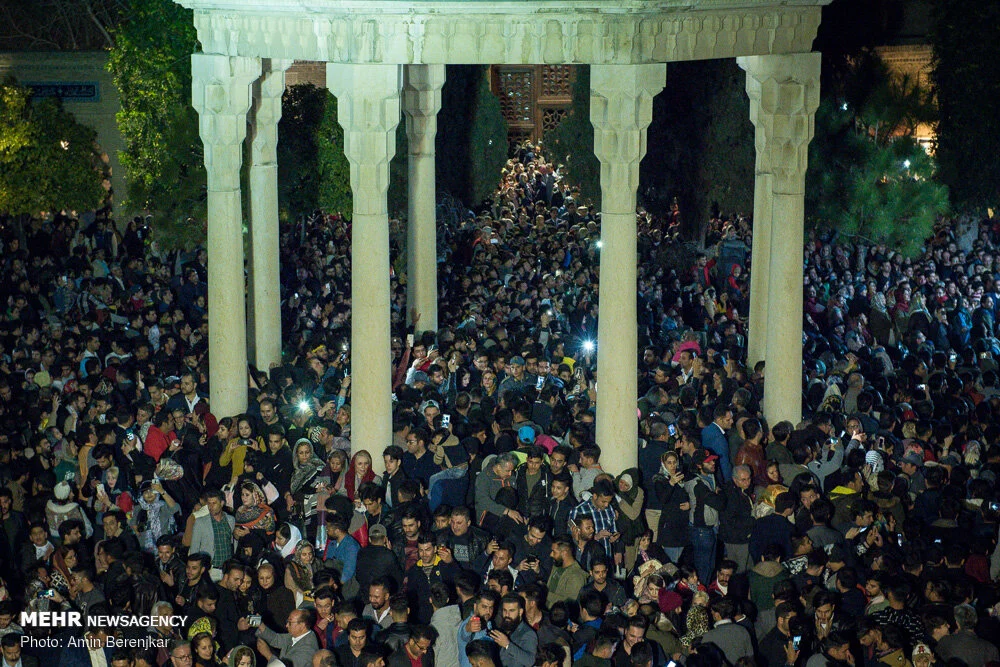(Photo: New Year’s eve at Hafiz’s mausoleum, Shiraz, March 2020; every year hundreds gather to share their New Year’s eve and day with Hafiz. Source: Mehr News Agency)

14th century gold-illuminated Divan of Hafez sells for £375,000 at Sotheby’s, June 19, 2020
Dr Leonard Lewisohn notes that ‘although Persian Sufi ideas constitute a significant feature of Rabindranath Tagore’s philosophical and mystical thought, these aspects are generally disregarded by critics of his writings*.
With no formal education, he received the 1913 literary Nobel Prize for his spiritual poems. In this series, we take a look at his upbringing and his views.

Tagore received the Nobel Prize for Literature in 1913 for his spiritual lyrical poem called گیتانجالی Gitanjali (Song offerings). He was the first non-European who received the award.
Almost 20 years after he received the Nobel Prize, he travelled to to Shiraz (Iran) to visit the tomb of Hafez, the poet who influenced Tagore’s, his father’s and his grandfather’s spiritual upbringing,

Seated from right: Dīnshāh Īrānī, Muḥammad Taqī Bahār, Tagore, ‘Alī Dashtī. Standing from right: Asadī, Rashīd, ‘Abbās Iqbāl, Sa‘īd Nafīsī, Ustād Falsafī, Muḥammad Sa‘īdī, Maykada.
Source: 1351 مجله موسیقی خرداد Majala-yi Mūsīqī (Khurdād 1351 A.Hsh./1972), 8
It was around the time that he religious war was spreading in India for decades. Tagore, the Indian poet was long puzzled over the ‘unfortunate India in the coils of intricate religion.’
”When will the liberation of India from the deadly blindness that goes by the name of religion occur?” he mused.138
The steward in charge of the tomb complex of Hafez. handed Tagore a large Ḥāfiẓ’s Divan (دیوان حافظ) or the book of Hafiz’s poetry.
He suggested the Tagore take an augury from Ḥāfiẓ’s poems by reading a poem from opening the book to a random page (an ancient Iranian tradition)

When Tahore opened the Divan, the immortal Ḥāfiẓ, known to Iranians as ‘the voice of the wise (‘لسان غیب’), offered these verses to the Bengali poet’s rumination over the evils of religious puritanism:13
بود آیا که در میکده ها بگشایند؟ … گره از کار فروبستهٔ ما بگشایند؟
اگر از بهر دل زاهد خودبین بستند … دل قوی دار که از بهر خدا بگشایند
Translation:
‘Will there ever be a time when the taverns’ door open again? Will there ever be a time when the deeply entangled affairs loosen up again? …’
… and Hafez promised that victory will be attained.
For centuries Iranians have been practicing seeking advice from Hafez when puzzled about something in personal or professional life. To this day; the art of divination by the poetry of Hafez is a popular activity among friends and families; young and old in Iran.


Hafez Commemoration Day on Iranian Calendar: 11th of October
در تقویم رسمی ایران ۲۰ مهر روز بزرگداشت حافظ نامیده شدهاست
Hafiz’s tomb, Shiraz, Iran
Hafez’s Advice For Rabindranath Tagore
Tweet
In this series we will know more about the Rabindranath Tagore family, get familiar with his pedagogy, and the widespread Persian culture of Bengal before the division into East and West Pakistan, and the role of Persian Islam in the Indian reform of Brahmo Samja.
- Hafez’s and Rabindranath Tagore
- Persian; the language of Bengal until British arrvide in 19th century
- Persian sufism and Indian reform; Ram Mouhan Roy (1772-1833)
- Imam Ali’s followers in a princely family; Rabindranath Tagore
- From avoiding schools to winning the literary Nobel prize
- Calcutta (19th century); the rendevous of Persian poets
- Rabindranath Tagore’s trip to Shiraz to visit Hafez (1932)
- Why did Tagore renounced his Knighthood
- Hungry Stones; an excerpt of a short story by Rabindranath Tagore
- Shiraz 1932; Tagore meditating beside the tomb of Hafez
Suggested readings and references:
Special thanks to Dr Leonard Lewisohn from the University of Exeter for his research that contributed to the main body of this series adaptation. Additional materials were sourced from Professor Emeritus Irfan Habib’s, and Dr Beatrice Teissier’s publications. Sentences showing an asterisk (*) above may be traced to the provided research materials containing over 145 Parsian and English academic references.
- Rabindranath Tagore’s Syncretistic Philosophy and the Persian Sufi Tradition, Leonard Lewisohn, University of Exeter, 2017, Published by Penn State University Press
- TEXTS FROM THE PERSIAN IN LATE EIGHTEENTH-CENTURY INDIA AND BRITAIN: CULTURE OR CONSTRUCT? Beatrice Teissier, Oriental Institute, Oxford, 2009, Published by Taylor & Francis, Ltd.
- Jallianwala Bagh Massacre, Irfan Habib, 2019, Published by Social Scientist
